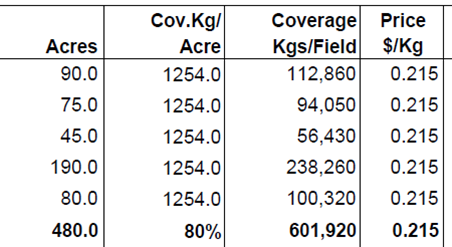Answering producers’ questions on grain volume measurements, moisture levels, the importance of accuracy
Crop InsuranceQ: Why does AFSC use a kilograms and tonnes to measure grain, while most producers use bushels?
For annual crops, Canada uses metric (kilograms and tonnes) for marketing of agricultural products, and AFSC provides and receives data from the federal government and industry in kilograms.
Insurance coverage is offered based on a weight measurement using kg/acre from a producer’s historic yields, or the area normal if they are a newer client. AFSC sets a designated grade for each crop we insure, and sets our spring prices based on the market values of those designated grades to calculate a dollar value on the insurance. You can see on the statement of coverage and premium example below that the coverage is in kg/acre.

Because most producers recognize their production in bushels, AFSC converts kilograms to bushels on the producer’s estimate, and asks for bushels on the Harvested Production Report (HPR).
Q: Why does AFSC adjust reported production for weight and dockage?
In the fall, the calculations to adjust reported production for weight and dockage are solely to determine the total weight the producer has harvested. Once the calculations are completed, the total weight harvested is compared to the weight the producer is insured for, in order to calculate potential claims and future coverage.
Q: What role does grade play in determining potential losses?
Designated grade is the grade established by the Canada Grain Commission (CGC), and assigned by AFSC for each insurable crop. AFSC uses the Canadian Grain Commission Grade Determinate Table as a standard for the designated grade for each crop, then converts that from kg/hl to lb/bu for the HPR, in order to ensure that every client is treated the same.
We’ll look at barley and oats as examples – Canada West (CW) being the standard for Alberta:

To get lb/bu from kg/hL you multiply by 0.801 and then round off to the nearest whole number:
- Barley = 63kg/hl x 0.801 = 50 lb/bu for 1CW
- Oats = 51kg/hl x 0.801 = 41 lb/bu for 3CW
To expand on the example, we recognize that a buyer may be using 48 pounds as a standard for 1CW barley or 34 pounds for 3CW oats when grading, but ultimately the buyers are paying the producer for their net weight after dockage based on the truck scale. They are not calculating how many bushels were delivered and converting using a pound measurement. When one looks at a sales slip, it doesn’t indicate the weight per bushel; the producer is not selling bushels, they are selling tonnes.
Losses on insured crops are based on production and quality. Where the crop is all harvested, the total production is adjusted for any quality, or grade, losses and compared to the total coverage to determine the amount of loss. AFSC determines a fall market price in order to compare the value of the harvested grade to the value of the designated grade to create a grade factor. Then, to compensate for grade loss, the affected production is multiplied by the appropriate grade factor, which decreases net production and increases potential indemnities.
Q: What happens if my insured crops receives a low grade due to moisture levels or other factors?
Many elements can influence the grade of a crop including moisture levels, disease such as ergot, and immature seeds mixed in with the mature ones. Sometimes the crop can be dried (DR) using a grain dryer or cleaned to improve the grade, or producers may choose to sell the crop as is and take a reduction in market price. Tough (TF) and Damp (DP) moisture ranges for Canadian grains can be found on CGC’s website.
For example, if the yield guarantee for canola at the coverage level selected is 35 bushels per acre and the spring insurance price per bushel is $10 (based on Designated Grade of 1 Canada), then liability or dollar coverage is:
- 35 bushels x $10 = $350 per acre
If a producer’s canola is grading at 3 Canada:
- 3CAN canola at a fall market price value of $8.23 / $10 (designated grade spring insurance price) = 0.823
- Harvested 22 bushels per acre of 3CAN x 0.823 factor = 18 bushels
- 35 bushels – 18 bushels = 17 bushels shortfall
- 17 bushels x $10 per bushel = $170 per acre indemnity
Q: Is everyone eligible for grade loss?
A grade factor calculation is applied to protect the value of coverage offered compared to the designated grade for all varieties registered under the Canada Seeds Act. In order to be eligible for grade loss, the acres must have been seeded prior to AFSC’s recommended seeding date and graded according to Canadian Grain Commissions (CGC) grading standards.
Q: Why is it important to include grade information on my Harvested Production Report?
When harvesting production it is strongly recommended that producers have samples graded in order to market the production, but also to report the results on the Harvested Production Report to ensure that AFSC is accurate in calculating potential claims as well as future coverage.
Q: Is there other information I should include?
Please report if the grain has be put through a grain dryer, or has ergot contamination. Advise AFSC of the measured weight per bushel and dockage, the grade (noting if it is TF, DP, DR or has ergot) and also when there is any volunteer constituting more than six per cent of the production.
Only when AFSC has all this information are we able to properly estimate actual production and determine if a producer is in a claim situation and compute future coverage.
For additional information, please use Live Chat on our website or AFSC Connect, call our Client Service Centre at 1.877.899.2372 or contact your branch office.
